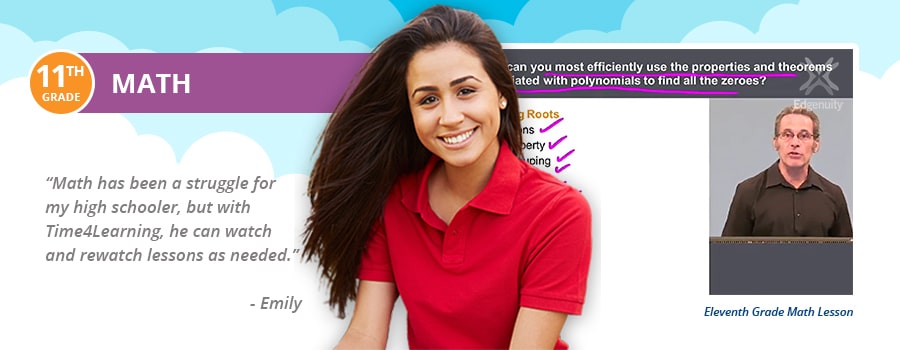11th Grade Math Curriculum
Students in grade 11 are expected to show clear understanding of core algebraic expressions, functions, and proficiency in collecting and analyzing data. During their junior year, most students take Algebra II, while others may take Geometry or even Pre-Calculus.
Whichever math course your junior high schooler takes, a good 11th grade math curriculum should provide comprehensive knowledge of the core math skills needed for higher education. Math lessons that are interactive, with exercises that show a variety of problems, and provide plenty of opportunities for math practice to successfully reach mastery is crucial.
Learn how Time4Learning’s math curriculum for 11th grade can help your student master important skills that will prepare them for college level mathematics.
What Math Should an 11th Grader Know?
Typically, students in grade 11 take Algebra II (if they followed the traditional course sequence: Algebra I in 9th grade, and Geometry in 10th grade). However, some students may be able to take Algebra I while still in 8th grade. In those cases, both 11th and 12th grade become open for advanced math options.
At the beginning of 11th grade, a lot of the foundations of Algebra are assumed to have already been mastered. With our 11th grade math curriculum, your junior student will learn:
- How to solve equations using quadratics and complex numbers.
- How to represent relationships between quantities using variables, equations, and inequalities.
- Proper operations on polynomials, including exponents and multiple variables.
- How to add, subtract, multiply, and divide rational functions and radical functions.
- To evaluate and graph trigonometric functions.
- How to use statistics and probability to represent and interpret data.
- About graphing logarithmic and trigonometric functions.
- How to represent relationships between quantities using mathematical modeling.
- Understand how to use a graphing calculator.
Learn more about Time4Learning’s eleventh grade math curriculum below.
Math Objectives for 11th Grade
Based on the typical course sequence involving Algebra II for 11th grade, here are some sample math goals and objectives:
- Solve one-variable linear inequalities, including compound inequalities, and represent the solutions sets graphically and algebraically.
- Find complex solutions to quadratic equations by completing the square.
- Analyze polynomials to factor them completely.
- Solve rational equations and determine extraneous solutions.
- Simplify algebraic expressions using properties of rational exponents.
- Identify and analyze the graphs of logarithmic functions.
- Create probability distributions from a data set.
- Convert between degree and radian measure.
- Use function models to make predictions about situations.
Get more detailed information on our Algebra 2 curriculum page.
Time4Learning 11th Grade Math Scope & Sequence
- Real Numbers
- Inequalities
- Word Problems
- Relations and Functions
- Function Operations
- Composition of Functions
- Symmetry
- Function Inverses
- Rate of Change
- Performance Task: Going on a Round Trip
- Complex Numbers
- Operations with Complex Numbers
- Completing The Square
- The Quadratic Formula
- Transformations of Quadratic Functions
- Square Root Functions
- Mixed Degree Systems
- Factoring Polynomials Completely
- Division of Polynomials
- The Binomial Theorem
- Synthetic Division and the Remainder Theorem
- The Rational Roots Theorem
- The Fundamental Theorem of Algebra
- Writing Polynomial Functions from Complex Roots
- Quadratic in Form Polynomials
- Graphing Polynomial Functions
- Solving Polynomial Equations using Technology
- Negative Exponents
- Simplifying Rational Expressions
- Multiplying and Dividing Rational Expressions
- Adding and Subtracting Rational Expressions
- Rational Equations
- Vertical Asymptotes of Rational Functions
- Graphing Rational Functions
- Modeling with Rational Functions
- Graphing Radical Functions
- Simplifying Nonperfect Roots
- Rational Exponents
- Adding and Subtracting Radicals
- Multiplying Radicals
- Dividing Radicals
- Radical Equations and Extraneous Roots
- Performance Task: Roller Coaster Design
- Cumulative Exam
- Graphing Exponential Functions
- Solving Exponential Equations by Rewriting the Base
- Graphing Logarithmic Functions
- Evaluating Logarithmic Expressions
- Solving Logarithmic Equations using Technology
- Properties of Logarithms
- Solving Equations using Properties of Logarithms
- Base e
- Geometric Series
- Designing a Study
- Representing Data
- Standard Deviation
- Properties of Probability Distributions
- Expected Value
- Binomial Distribution
- Introduction to Normal Distributions
- Applications with Standard Normal Distribution
- Statistical Inferences
- Hypothesis Testing
- Angles in Standard Position
- Radian Measure
- Right Triangle Trigonometry
- The Unit Circle
- Reciprocal Trigonometric Functions
- Evaluating the Six Trigonometric Functions
- Graphing Sine and Cosine
- Changes in Period and Phase Shift of Sine and Cosine Functions
- Modeling with Periodic Functions
- Linear Programming
- Modeling with Systems
- Piecewise Defined Functions
- Joint and Combined Variation
- Transformations of Functions
- Modeling with Functions
- Performance Task: Production Schemes
- Cumulative Exam
Why Choose Time4Learning 11th Grade Math Homeschool Curriculum?
Many homeschoolers choose Time4Learning’s grade 11 math curriculum as the full year’s math program. Alternatively, some families choose to use Time4Learning’s 11th grade math curriculum as an afterschool supplement to review material, improve on challenging topics, or prepare for advanced coursework or college admissions/placement.






